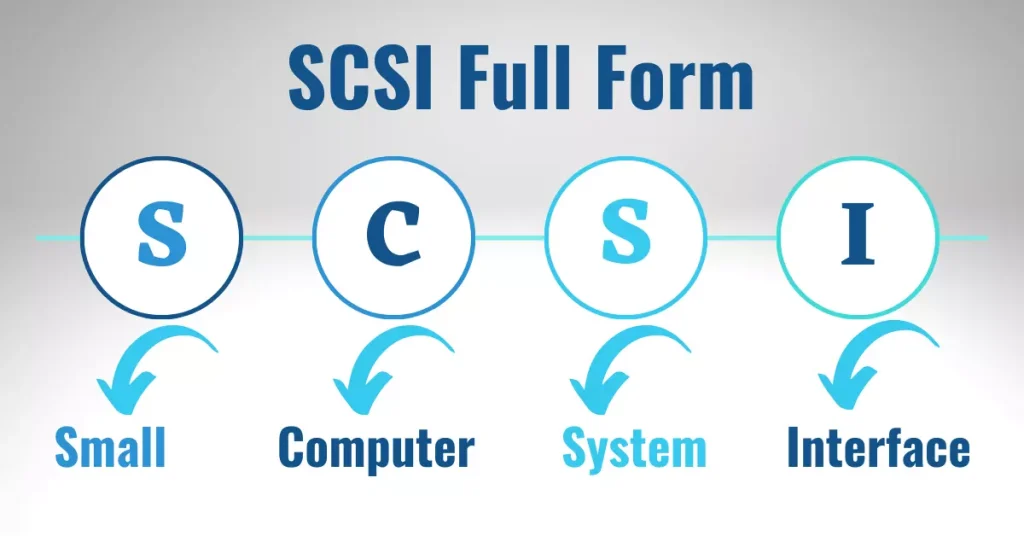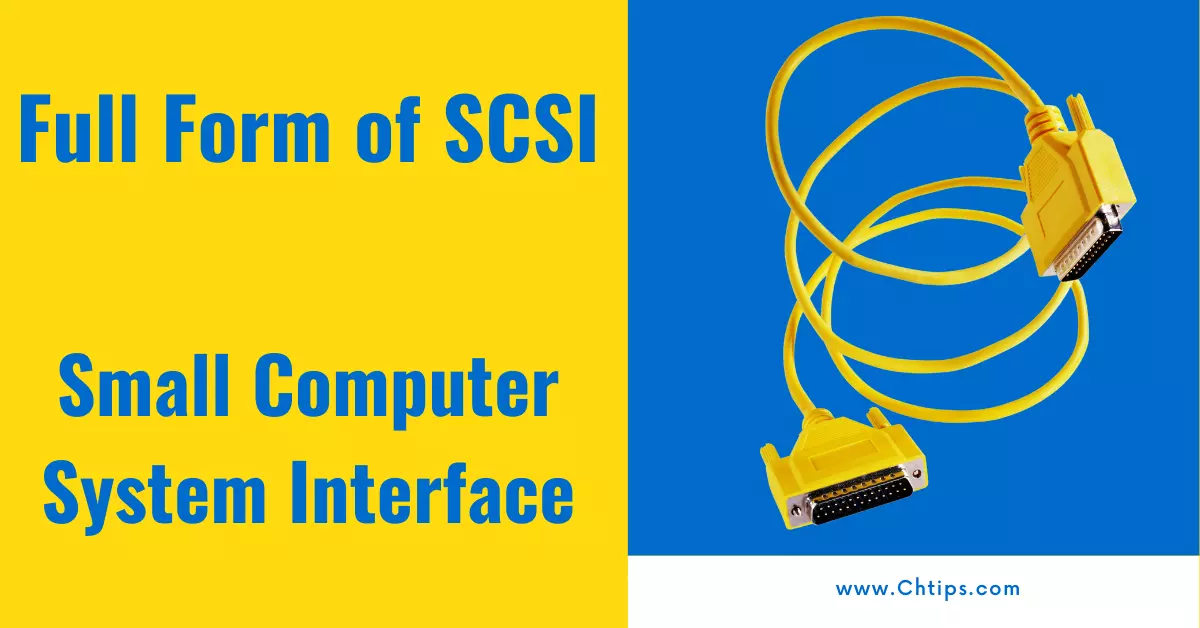The full form of SCSI is Small Computer System Interface. SCSI is a type of interface which is used and utilized in computer devices like hard disk drives, scanners, tape drives. The SCSI is an alternative to old IDE [Integrated Device Integration]. The IDE is pre-installed on computer motherboard whereas SCSI is additional device which can be installed anytime on the motherboard. The SCSI card can be installed on the motherboard to enable other devices to attach to these cards.
| S | Small |
| C | Computer |
| S | System |
| I | Interface |
What is SCSI in Computer Technology?
SCSI stands for Small Computer System Interface, which uses the same transmission interface / technology that is used to connect external parts to computers with a standard hardware base specification.
The Small Computer System Interface (SCSI) was designed and developed by Apple Inc. for storage that was extensively used in personal computers.
The Microsoft Cluster Server (MSCS) is used to failover between two computers sharing a SCSI bus, on which Microsoft Windows NT Server Enterprise Version is installed.
The SCSI interface is primarily used for high-speed hard drives.
The SCSI devices primary used because they are capable of faster data and information transfer; they are comparatively faster than old IDE [Integrated Development Environment] storage devices.
SCSI stands for Small Computer System.
Daisy-chaining is also supported with SCSI, so if you have too many SCSI hard drives, they are linked to a SCSI, therefore no performance degradation happens.
Small computer system interfaces are used to connect peripheral devices with a computer.
In accordance with the specifications, the device can respond to 16 external devices with a single adapter.
The small system computer boosted the display, transferred faster data, and provided comprehensive expansion for the machines with CD-ROM drivers, scanners, and DVD drives.
It has control over the small computer bus. It is responsible for transferring data into the computer on the motherboard, or the motherboard’s client adapter is on the motherboard.
The system also uses a simple SCSI input/output system, a tiny chip that provides access and control tools and the necessary software.
An identification number for SCSI has actually been assigned making use of serial storage space architecture initiators newer serial SCSI IDs such as Serial Connected SCSI make use of an automated procedure that establishes a seven-bit number.
Full Form of SCSI

Why is SCSI Used?
The small computer system interface is a set of connections connecting external devices to a computer like printers, disk drives, scanners, etc.
It was developed by the American National Standard Institute (ANSI) according to similar standards.
The chief operating system organization supported SCSI.
The Universal serial bus is activated when we plug in our MP3 player and digital camera to our computer.
The USB port for small electronic devices is essential for data and power to create images, music files, and archives.
Nevertheless, it is not so large that they provide support for the computer, server, and most devices.
This requires more support than SCSI can provide.
The full form of SCSI is Small Computer System Interface.
This fast bus connects hard drives, scanners, CD-ROM drives, and printers with computer system.
Like other techniques, serial ATA (SATA) has been altered significantly on new systems, but it is still used in today’s world.
Who Invented SCSI?
SCSI [Small Computer System Interface] is old technology and is based on a bus interface.
SASI was developed by Shugart Associates with NCR Corporation in 1981.
SCSI was confirmed by American National Standard Institute in 1986 as a revised version of SASI.
SCSI hard drives and printers can send power and data use control. SCSI has many advantages; it speed is 320 megabytes per second, which is very fast.
With Serial ATA and Firewire, you can keep many items on a single bus, and SCSI also connects to computer system. However, SCSI has some potential problems.
Unlike most systems BIOS, it has limited support and has to be customized for each computer.
There is also no standard SCSI software interface. Lastly, all the different SCSI types have different speeds, bus widths, and connectors, which is confusing.
How Many Types of SCSI are There?
SCSI controller, SCSI bus, computer coordinate between devices. They are also called host adaptor which is in the form of cards and can be plugged into the slot which is built on motherboard.
SCSI BIOS is also on the controller.
It is a chip which is pre-programmed by software developer
All SCSI devices have one unique id, so they work correctly.
For example, 16 digits were given to every device support, and then they specified by their ID of hardware and software from 0 to 15.
SCSI use one ID, usually the highest one, and leaving room for 15 other devices on the bus.
An internal device with one ribbon connects SCSI control, the Outer SCSI device is fat, and the round cable connects with the daisy chain.
(It use serial attached SCSI device) it is connected with every other device in the daisy chain; for this reason, it combines the external devices with two different devices.
The last device is connected in front of the following device and vice-versa.
Cable has three layers:
Inner layer: It is the most secure layer on which there is sending of data.
Media layer: There is a wire that controls the command with devices.
Outer layer: The wire sends information and confirms that data is safe.
Different SCSI variants use other connectors, which are often incompatible.
These connectors typically use pins 50, 68 or 80. SAS uses smaller, SATA-compatible connectors.
Once all the equipment on the bus is installed and they have their ID, each end of the bus should be closed. We will see further how to do this.
What is the Difference Between IDE and SCSI?
| IDE | SCSI |
| IDE is cheaper | SCSI is expensive |
| IDE allows two devices per channel | SCSI has two channels. |
| IDE is easier to set up | SCSI is difficult compared to IDE |
| IDE and SCSI drive runs at the same RPM. | IDE and SCSI drive runs at the same RPM. |
| Requires Expansion Slots | Requires Expansion Slots |
What are SCSI and SATA?
SCSI is known as Small Computer System Interface.
It is an interface of the computer mainly used as higher speed hard drives.
This is because this is commonly used in the IDE storage interface they transfer faster data.
SCSI supports a daisy-chaining device which means that SCSI hard drive is connected with the SCSI.
SCSI-1: 8 bit uses the bus, supporting 4 Mbps data transfer.
SCSI-2: On behalf of the 25 pin connector, they use a 50-pin connector and support most devices. It is the maximum used device SCSI, and the transfer speed of the data is 5 Mbps.
Related Articles
- Full Form of Virus
- Full Form of PDF in Computer
- Full Form of HREF in Computer
- Full Form of HDMI in Computer
- Full Form of PAN in Computer
- Full Form of OMR in Computer
- Full Form of CU in Computer
- Full Form of DSL in Computer
- Full Form of TFT in Computer
- Full Form of FORTRAN in Computer
- Full Form of ALU in Computer
- What is the Full Form of GIGO
- What is the Full Form of USB in Computer
- Full Form of WAN in Computer
- Computer Basic Tutorials
Which is Faster IDE or SATA?
SATA cables are thin and flexible as compared to PATA.
SATA are more advanced devices compared to their counterparts data transfer range is between 150 MB/s to 300 Mb/s for SATA.
It is a serial conductor and gives faster performance and support with hot plugging.
Frequently Asked Questions [FAQs]
Full Form of SATA
Full Form of PATA
Why is SCSI Used?
What is SCSI ID Number?
How Fast is SCSI?
Get In Touch
I have also written and compiled some articles on computers and telecommunications, and please go through them.
I hope that all the questions and queries related to the What is the full form of SCSI in Computer System | SCSI full form has been answered here.
I hope you will like reading it.
If you have any questions related to what does SCSI stands for in computer technology.
Don’t hesitate to get in touch with me, and if you need to add, remove or update anything from the article, please let me know in the comment section or via email.
I will be more than happy to update the article. I am always ready to correct myself.
Please share this article with your friends and colleagues; this motivates me to write more related topics.
!!! Thank You !!!

Comments are closed.